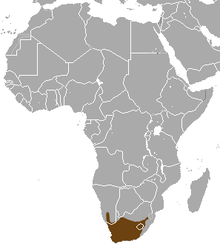Galerella pulverulenta
| Cape gray mongoose | |
|---|---|
 |
|
| Probable male in residential area, Western Cape | |
| Scientific classification | |
| Kingdom: | Animalia |
| Phylum: | Chordata |
| Class: | Mammalia |
| Order: | Carnivora |
| Family: | Herpestidae |
| Subfamily: | Herpestinae |
| Genus: | Galerella |
| Species: | G. pulverulenta |
| Binomial name | |
|
Galerella pulverulenta (Wagner, 1839) |
|
 |
|
| Cape gray mongoose range | |
The Cape gray mongoose (Galerella pulverulenta), also called the small gray mongoose, is a mongoose endemic to southern Africa.
It is a small species (55–69 cm long, weight range 0.5 – 1.0 kg). It is a dark grey colour with a darker tip of the tail. The legs are a darker grey than the rest of the body. It has a typical elongated mongoose body-shape. The ears are small and rounded and are situated on the sides of the head. The tail is long and bushy. The teeth show adaptations for both cutting and crushing.
The Cape grey mongoose feeds mostly on insects and small rodents, but will also eat birds, small reptiles, amphibians, other invertebrates, and fruit. They have been known to eat carrion and garbage as well.
It is predominantly insectivorous but also carnivorous. Insects and other arthropoda such as spiders are caught on the ground and then held down with the forefeet and eaten. Larger prey such as rodents are stalked and killed with a bite to the head. Large prey items are held down with the forefeet and then torn into bite size pieces with the teeth.
Small rodents, in particular Otomys and Rhabdomys, are their most important dietary component. On occasion, immature hares or the young of small antelopes such as Cape grysbok may be attacked.
Until a few decades ago, the species was thought to be endemic to the Cape Province, but it is now known to occur in much of the rest of South Africa and in the west, northwards to southern Angola. It is not yet clear how continuous the range is, nor how much of this wider presence is due to extension of its range. Its density in areas where the species is established, ranges from one mongoose per 60 hectares to one per two hectares.
It inhabits macchia-type vegetation (fynbos), semi-desert scrub (Karoo), thicket and forest. However, it is not found in the grassland biome. Often they live in close association with man, often under the floors of outbuildings, and even live successfully on the fringe of suburbia. When habituated to human presence, they may tolerate close approach.
...
Wikipedia

